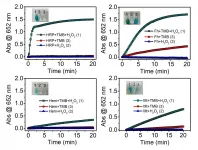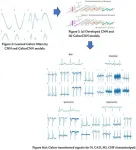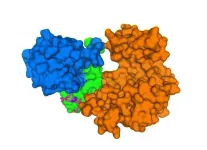(Press-News.org) Globally, the Earth system has thousands of terragrams (Tg) (1 Tg = 10 12 g) of mineral nanoparticles moving around the planet each year. These mineral nanoparticles are ubiquitously distributed throughout the atmosphere, oceans, waters, soils, in and/or on most living organisms, and even within proteins such as ferritin. In natural environments, mineral nanozymes can be produced by two pathways: "top down" and "bottom up" processes. Specifically, the weathering or human-promoted breakdown of bulk materials can result in nanomaterials directly (a top-down process), or nanomaterials can grow from precursors through crystallization, reaction, or biological roles (a bottom-up process).
These mineral nanoparticles can possess multiple enzyme-like properties, e.g., oxidase, peroxidase, catalase, and superoxide dismutase, depending on the local environment. Iron-containing minerals, e.g., ferrihydrite, hematite, and magnetite, are ubiquitous in Earth systems and possess peroxidase-like activity (Figure 1). Among these iron (oxyhydr)oxides, ferrihydrite exhibited the highest peroxidase-like activity, owing to its smallest particle size and largest specific surface area. Because of the presence of ferrous iron, magnetite has considerably high peroxidase-like activity.
Compared with natural enzymes, mineral nanozymes show several advantages, such as low cost, increased stability, sustainable catalytic activity, and robustness to harsh environments. Because of their larger specific surface area, high ratios of surface atoms, wide band gap, and strong catalytic activities, mineral nanozymes play essential roles in biogeochemical cycles of elements in ecosystems.
Fungi and bacteria contribute approximately 70 Gt carbon (C) (1 Gt = 10 9 t) and 120 Gt C to global biomass, respectively. Given that fungal hyphae can cumulatively extend hundreds of kilometers in soils kg-1 in environments such as the rhizosphere (i.e., 200-800 km kg-1) and that more than 94% of land plants and fungi form a symbiotic relationship, mineral nanozymes may have important implications in microbial-mineral coevolution, nutrient cycling in the surface Earth system, mineral carbon sequestration, and alleviation of global climate changes.
In Earth systems, taxonomically and functionally diverse microorganisms are a vast source of superoxide (O2* -) or hydrogen peroxides (H2O2). These mineral nanozymes can regulate the levels of reactive oxygen species (ROS), including H2O2, O2* - and hydroxyl radicals (HO* ). By producing a strong oxidative HO* , the interaction between mineral nanozymes and microorganisms may play an important role in driving the biogeochemical cycle of elements (Figure 2).
"All of the investigations on mineral nanozymes are still in the laboratory stage and are not field studies," said Guang-Hui Yu, a scientist at the School of Earth System Science, Tianjin University, in the Chinese city of Tianjin.
"The catalytic activity of mineral nanozymes is mainly determined by the oxygen vacancies (OVs) on the mineral surface", the researchers wrote in an article titled "Fungal Nanophase Particles Catalyze Iron Transformation for Oxidative Stress Removal and Iron Acquisition."
"These oxygen vacancies are often occupied by hydroxyl groups on the mineral surface," they explained.
Since mineral nanozymes can catalyze H2O2 to produce highly oxidizing HO* , they have been extensively used in the field of environmental remediation. Compared with natural enzymes, mineral nanozymes can degrade organic pollutants in a wider pH range. For example, by degrading H2O2, Fe3O4 nanoparticles could effectively remove rhodamine B (RhB) in the pH range from 3.0 to 9.0.
"The effects of mineral nanozymes on microbial communities in the environment remain unclear," wrote the two researchers, "the findings of mineral nanozymes may have revealed a previously unknown feedback route of microbe-mineral coevolution that could shed light on a number of long-standing questions, such as the origin and evolution of life by modulating ROS levels."
These two scholars likewise revealed in the study, which was published in the Science China Earth Sciences, that the discovery of nanomaterials as new enzyme mimetics has changed the traditional idea that nanomaterials are chemically inert in Earth systems. Given the terragram (Tg)-level abundance of mineral nanoparticles in Earth systems, it is statistically highly probable for some of them, particularly those of biotic origin, to behave as mineral nanozymes to catalyze superoxide and H2O2 and promote the biogeochemical cycles of oxygen and other elements.
INFORMATION:
This research was supported by the National Natural Science Foundation of China (Grant No. 41977271) and the National Key Basic Research Program of China (Grant No. 2020YFC1806803).
See the article: Z.-L. Chi, G.-H. Yu. Nanozyme-mediated elemental biogeochemical cycling and environmental effects. Science China Earth Sciences, 2021, 64, https:// doi.org/10.1007/s11430-020-9756-5
A team of researchers from Nanyang Technological University, Singapore (NTU Singapore), Ngee Ann Polytechnic, Singapore (NP), and the National Heart Centre Singapore (NHCS) have invented a tool that could speed up the diagnosis of cardiovascular diseases.
Powered by artificial intelligence (AI), their innovation uses electrocardiograms (ECGs) to diagnose coronary artery disease, myocardial infarction and congestive heart failure to an accuracy of more than 98.5 per cent.
The joint development of the diagnostic tool is timely, as the number of deaths caused by cardiovascular disease in Singapore has increased over the past three years. According to the Singapore Heart Foundation, 29.3 per cent of all deaths in Singapore in 2019, or almost 1 out of 3 deaths in Singapore, was due to heart ...
Osteoporosis is a condition that does not exhibit symptoms until there is a bone fracture, so it is said that there is a high percentage of people who remain unaware of their condition. When people are unaware their bones have weakened, the condition is left untreated, and the recent rise of the elderly population has caused an increase in bone fractures. This has a large societal impact, such as overwhelming medical costs and long-term care. Simple screenings at resident health exams are one way for an increase in osteoporosis detecting without having to go to the hospital. When suspected osteoporosis and osteopenia is properly detected and patients are encouraged to get further evaluation at the hospital, ...
Scientists have observed for the first time what it looks like in the key memory region of the brain when a mistake is made during a memory trial. The findings have implications for Alzheimer's disease research and advancements in memory storage and enhancement, with a discovery that also provides a view into differences between the physiological events in the brain during a correct memory versus a faulty one.
The study was published today in the journal Nature Communications.
In both correct and incorrect recall of a spatial memory, researchers could observe patterns of cell activation in the brain that were similar, though the pace of activation differed.
"We could see the memories activating," said Laura Colgin, an associate professor of neuroscience at The University ...
SAN RAMON, Calif., June 8, 2021--CooperVision today announced its scientific research program for the 2021 British Contact Lens Association Virtual Clinical Conference and Exhibition, which begins Sunday, June 13. For the first time, the biennial event will be streamed live over the course of 30 hours, welcoming members of the global eye care community to experience and discuss the latest category advancements.
More than 20 CooperVision-authored and sponsored investigations were accepted by the conference committee. The papers and posters span a range of topics that underpin the contact lens industry's evolution, including new data and insights on the complex lifestyle factors involved with addressing presbyopia, misperceptions surrounding soft toric lens fitting, ...
An unprecedented analysis of almost 10,000 Harmful Algal Bloom (HAB) events worldwide over the past 33 years was launched today by UNESCO's Intergovernmental Oceanographic Commission.
The first-ever global statistical analysis examined ~9,500 HABs events over 33 years and found that the harm caused by HABs rises in step with growth of the aquaculture industry and marine exploitation and calls for more research on linkages.
Conducted over seven years by 109 scientists in 35 countries, the study found that reported HAB events have increased in some regions and decreased or held steady in others. ...
UPTON, NY--Scientists at the U.S. Department of Energy's (DOE) Brookhaven National Laboratory have published the first detailed atomic-level model of the SARS-CoV-2 "envelope" protein bound to a human protein essential for maintaining the lining of the lungs. The model showing how the two proteins interact, just published in the journal Nature Communications, helps explain how the virus could cause extensive lung damage and escape the lungs to infect other organs in especially vulnerable COVID-19 patients. The findings may speed the search for drugs to block the most severe effects of the disease.
"By obtaining atomic-level details of the protein interactions we can explain why the damage occurs, and search for inhibitors ...
Natural selection can reverse evolution that occurs through sexual selection and this can lead to better females, new research shows.
The study - led by the University of Exeter and Okayama University - examined broad-horned flour beetles, whose males have exaggerated mandibles, while females do not.
Male beetles with the largest mandibles win more fights and mate with more females - an example of "sexual selection", where certain characteristics (like a male peacock's tail) improve mating success.
However, having bigger mandibles requires a masculinised body (large head and neck), ...
Women who will develop potentially life-threatening disorders during pregnancy can be identified early when hormone levels in the placenta are tested, a new study has shown.
Pregnancy disorders affect around one in ten pregnant women. Nearly all of the organ systems of the mother's body need to alter their function during pregnancy so that the baby can grow. If the mother's body cannot properly adapt to the growing baby this leads to major and common issues including fetal growth restriction, fetal over-growth, gestational diabetes, and preeclampsia - a life-threatening high blood pressure ...
New research has shown that by injecting an alkalinizing agent into the ocean along the length of the Great Barrier Reef, it would be possible, at the present rate of anthropogenic carbon emissions, to offset ten years' worth of ocean acidification.
The research, by CSIRO Oceans and Atmosphere, Hobart, used a high-resolution model developed for the Great Barrier Reef region to study the impact of artificial ocean alkalinization on the acidity of the waters in the Great Barrier Reef. The study is based on the use of existing shipping infrastructure to inject a source of alkalinity into the ocean, which could also be considered as an acceleration of the chemical weathering of minerals through natural ...
Researchers from the Hong Kong University of Science and Technology (HKUST) and Beijing Tiantan Hospital have recently uncovered a new gene mutation responsible for the non-familial patients of cerebral cavernous malformation (CCM) - a brain vascular disorder which inflicted about 10~30 million people in the world.
While the mutation of three genes: namely CCM1, CCM2, and CCM3, were known to be a cause of CCM - they mostly targeted patients who has family history in this disorder - which only account for about 20 per cent of the total inflicted ...







